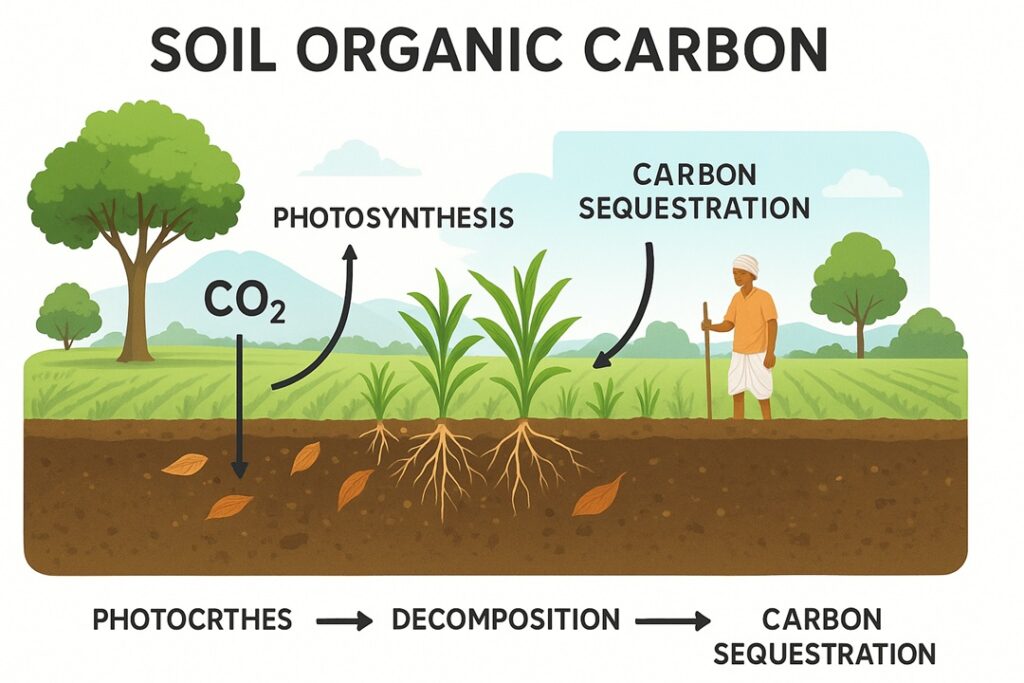Soil Organic Carbon: The Foundation of Soil Health and Climate Resilience

Context
A comprehensive study by the Indian Council of Agricultural Research (ICAR) has revealed that unscientific fertiliser use and climate change are leading to the degradation of soil organic carbon (SOC) in India’s arable lands. This decline threatens soil fertility, agricultural productivity, and long-term ecological balance.
Definition of Soil Organic Carbon
- SOC refers to the carbon present in different stages of decomposition of organic matter in the soil.
- It forms around 58% of the total soil organic matter (SOM).
Composition and Formation
- It consists of plant residues, microbial biomass, and stable forms such as humus and charcoal.
- SOC enters the soil through plant roots, fallen leaves, and organic residues formed during photosynthesis.
Importance of Soil Organic Carbon
Soil Fertility and Productivity
- Enhances soil structure and aeration, improving root growth.
- Increases water-holding capacity and nutrient availability.
- Provides nourishment for soil microorganisms and plant growth.
Environmental Role
- Serves as a major terrestrial carbon sink, mitigating climate change impacts.
- Improves soil heat absorption, reducing ground-level heat reflection.
- Enhances resilience against climatic stresses like droughts and floods.
- Contributes to water purification by filtering contaminants.
Details of the ICAR Study
- Conducted by ICAR’s Indian Institute of Soil Science, Bhopal.
- Covered 20 agro-ecological regions using over 2.5 lakh soil samples from 620 districts across 29 states.
- Developed an agro-ecological map linking cropping patterns, fertiliser usage, and SOC content.
- The findings were published in the international journal “Land Degradation & Development.”
Major Findings of the Study
Nutrient–Carbon Relationship
- Soils with low organic carbon levels show higher micronutrient deficiencies.
- Higher SOC levels correspond to better nutrient availability.
Climatic and Geographical Factors
- Temperature, rainfall, and elevation are key determinants of SOC levels.
- Higher elevations show more SOC, while lowlands show less.
- SOC is negatively correlated with temperature, with hotter regions like Rajasthan and Telangana showing lower carbon levels.
Cropping System Influence
- Rice and pulse-based cropping systems have higher SOC due to more microbial activity and water retention.
- Wheat and coarse-grain systems tend to have lower SOC.
- The mapping supports future policies on carbon credits and land degradation assessment.
Effect of Fertiliser Usage
- Imbalanced fertiliser application reduces SOC content.
- States like Punjab, Haryana, and Western Uttar Pradesh show SOC decline due to overuse of fertilisers.
- Bihar shows better SOC status with balanced fertiliser application.
Impact of Climate Change
- Rising temperatures and erratic rainfall patterns are expected to further reduce SOC levels in the future.
Way Forward
Sustainable Agricultural Practices
- Promote continuous soil cover through crop rotation and green manuring.
- Encourage organic carbon sequestration in soils with low carbon content.
Policy Measures
- Provide incentives to farmers adopting carbon-positive farming methods.
- Integrate SOC management into national soil health and climate adaptation programmes.
Scientific Interventions
- Develop region-specific cropping and fertiliser management systems to improve SOC retention.
- Promote large-scale afforestation and sustainable land-use planning.
Conclusion
Soil Organic Carbon is fundamental to maintaining soil health, agricultural sustainability, and environmental stability. The ICAR study underlines the urgent need for balanced fertiliser use, climate-resilient cropping systems, and carbon sequestration strategies to restore and sustain India’s soil fertility for future generations.
Source : The Hindu
